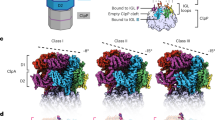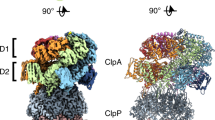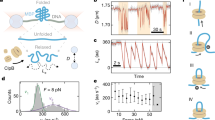Abstract
Hexameric ATP-dependent proteases and protein remodeling machines use conserved loops that line the axial pore to apply force to substrates during the mechanical processes of protein unfolding and translocation. Whether loops from multiple subunits act independently or coordinately in these processes is a critical aspect of the mechanism but is currently unknown for any AAA+ machine. By studying covalently linked hexamers of the Escherichia coli ClpX unfoldase bearing different numbers and configurations of wild-type and mutant pore loops, we show that loops function synergistically, and the number of wild-type loops required for efficient degradation is dependent on the stability of the protein substrate. Our results support a mechanism in which a power stroke initiated in one subunit of the ClpX hexamer results in the concurrent movement of all six pore loops, which coordinately grip and apply force to the substrate.
This is a preview of subscription content, access via your institution
Access options
Subscribe to this journal
Receive 12 print issues and online access
$259.00 per year
only $21.58 per issue
Buy this article
- Purchase on Springer Link
- Instant access to full article PDF
Prices may be subject to local taxes which are calculated during checkout






Similar content being viewed by others
Change history
30 January 2015
There was a mismatch between the PDF and the HTML versions upon online release. In addition, the title of the article and the third sentence of the article have been modified by changing 'an' to 'a' before AAA+. The first sentence of the first paragraph was edited incorrectly and has been modified to reflect the correct meaning. Finally, in the last sentence on page 5, the word 'given' has been modified to 'based on'. These errors have been corrected in the HTML and PDF versions of the article.
References
Ogura, T. & Wilkinson, A.J. AAA+ superfamily ATPases: common structure–diverse function. Genes Cells 6, 575–597 (2001).
Sauer, R.T. & Baker, T.A. AAA+ proteases: ATP-fueled machines of protein destruction. Annu. Rev. Biochem. 80, 587–612 (2011).
Baker, T.A. & Sauer, R.T. ClpXP, an ATP-powered unfolding and protein-degradation machine. Biochim. Biophys. Acta 1823, 15–28 (2012).
Siddiqui, S.M., Sauer, R.T. & Baker, T.A. Role of the protein-processing pore of ClpX, an AAA+ ATPase, in recognition and engagement of specific protein substrates. Genes Dev. 18, 369–374 (2004).
Martin, A., Baker, T.A. & Sauer, R.T. Protein unfolding by a AAA+ protease is dependent on ATP-hydrolysis rates and substrate energy landscapes. Nat. Struct. Mol. Biol. 15, 139–145 (2008).
Martin, A., Baker, T.A. & Sauer, R.T. Pore loops of the AAA+ ClpX machine grip substrates to drive translocation and unfolding. Nat. Struct. Mol. Biol. 15, 1147–1151 (2008).
Glynn, S.E., Martin, A., Nager, A.R., Baker, T.A. & Sauer, R.T. Structures of asymmetric ClpX hexamers reveal nucleotide-dependent motions in a AAA+ protein-unfolding machine. Cell 139, 744–756 (2009).
Glynn, S.E., Nager, A.R., Baker, T.A. & Sauer, R.T. Dynamic and static components power unfolding in topologically closed rings of a AAA+ proteolytic machine. Nat. Struct. Mol. Biol. 19, 616–622 (2012).
Stinson, B.M. et al. Nucleotide binding and conformational switching in the hexameric ring of a AAA+ machine. Cell 153, 628–639 (2013).
Kenniston, J.A., Baker, T.A. & Sauer, R.T. Partitioning between unfolding and release of native domains during ClpXP degradation determines substrate selectivity and partial processing. Proc. Natl. Acad. Sci. USA 102, 1390–1395 (2005).
Aubin-Tam, M.-E., Olivares, A.O., Sauer, R.T., Baker, T.A. & Lang, M.J. Single-molecule protein unfolding and translocation by an ATP-fueled proteolytic machine. Cell 145, 257–267 (2011).
Maillard, R.A. et al. ClpX(P) generates mechanical force to unfold and translocate its protein substrates. Cell 145, 459–469 (2011).
Sen, M. et al. The ClpXP protease unfolds substrates using a constant rate of pulling but different gears. Cell 155, 636–646 (2013).
Cordova, J.C. et al. Stochastic but highly coordinated protein unfolding and translocation by the ClpXP proteolytic machine. Cell 158, 647–658 (2014).
Song, H.K. et al. Mutational studies on HslU and its docking mode with HslV. Proc. Natl. Acad. Sci. USA 97, 14103–14108 (2000).
Yamada-Inagawa, T., Okuno, T., Karata, K., Yamanaka, K. & Ogura, T. Conserved pore residues in the AAA protease FtsH are important for proteolysis and its coupling to ATP hydrolysis. J. Biol. Chem. 278, 50182–50187 (2003).
Hinnerwisch, J., Fenton, W.A., Furtak, K.J., Farr, G.W. & Horwich, A.L. Loops in the central channel of ClpA chaperone mediate protein binding, unfolding, and translocation. Cell 121, 1029–1041 (2005).
Graef, M. & Langer, T. Substrate specific consequences of central pore mutations in the i-AAA protease Yme1 on substrate engagement. J. Struct. Biol. 156, 101–108 (2006).
Okuno, T., Yamanaka, K. & Ogura, T. Characterization of mutants of the Escherichia coli AAA protease, FtsH, carrying a mutation in the central pore region. J. Struct. Biol. 156, 109–114 (2006).
Rothballer, A., Tzvetkov, N. & Zwickl, P. Mutations in p97/VCP induce unfolding activity. FEBS Lett. 581, 1197–1201 (2007).
Zhang, F. et al. Structural insights into the regulatory particle of the proteasome from Methanocaldococcus jannaschii. Mol. Cell 34, 473–484 (2009).
Martin, A., Baker, T.A. & Sauer, R.T. Rebuilt AAA+ motors reveal operating principles for ATP-fuelled machines. Nature 437, 1115–1120 (2005).
Kim, Y.I. et al. Molecular determinants of complex formation between Clp/Hsp100 ATPases and the ClpP peptidase. Nat. Struct. Biol. 8, 230–233 (2001).
Barkow, S.R., Levchenko, I., Baker, T.A. & Sauer, R.T. Polypeptide translocation by the AAA+ ClpXP protease machine. Chem. Biol. 16, 605–612 (2009).
Kenniston, J.A., Baker, T.A., Fernandez, J.M. & Sauer, R.T. Linkage between ATP consumption and mechanical unfolding during the protein processing reactions of an AAA+ degradation machine. Cell 114, 511–520 (2003).
Nager, A.R., Baker, T.A. & Sauer, R.T. Stepwise unfolding of a β-barrel protein by the AAA+ ClpXP protease. J. Mol. Biol. 413, 4–16 (2011).
Hersch, G.L., Burton, R.E., Bolon, D.N., Baker, T.A. & Sauer, R.T. Asymmetric interactions of ATP with the AAA+ ClpX6 unfoldase: allosteric control of a protein machine. Cell 121, 1017–1027 (2005).
Smith, D.M., Fraga, H., Reis, C., Kafri, G. & Goldberg, A.L. ATP binds to proteasomal ATPases in pairs with distinct functional effects, implying an ordered reaction cycle. Cell 144, 526–538 (2011).
Matyskiela, M.E., Lander, G.C. & Martin, A. Conformational switching of the 26S proteasome enables substrate degradation. Nat. Struct. Mol. Biol. 20, 781–788 (2013).
Olivares, A.O., Nager, A.R., Yosefson, O., Sauer, R.T. & Baker, T.A. Mechanochemical basis of protein degradation by a double-ring AAA+ machine. Nat. Struct. Mol. Biol. 21, 871–875 (2014).
Schmitz, K.R. & Sauer, R.T. Substrate delivery by the AAA+ ClpX and ClpC1 unfoldases activates the mycobacterial ClpP1P2 peptidase. Mol. Microbiol. 93, 617–628 (2014).
Martin, A., Baker, T.A. & Sauer, R.T. Diverse pore loops of the AAA+ ClpX machine mediate unassisted and adaptor-dependent recognition of ssrA-tagged substrates. Mol. Cell 29, 441–450 (2008).
Martin, A., Baker, T.A. & Sauer, R.T. Distinct static and dynamic interactions control ATPase-peptidase communication in a AAA+ protease. Mol. Cell 27, 41–52 (2007).
Burton, R.E., Siddiqui, S.M., Kim, Y.I., Baker, T.A. & Sauer, R.T. Effects of protein stability and structure on substrate processing by the ClpXP unfolding and degradation machine. EMBO J. 20, 3092–3100 (2001).
Lee, M.E., Baker, T.A. & Sauer, R.T. Control of substrate gating and translocation into ClpP by channel residues and ClpX binding. J. Mol. Biol. 399, 707–718 (2010).
Gur, E. & Sauer, R.T. Degrons in protein substrates program the speed and operating efficiency of the AAA+ Lon proteolytic machine. Proc. Natl. Acad. Sci. USA 106, 18503–18508 (2009).
Acknowledgements
This work was supported by US National Institutes of Health grant GM-101988 (R.T.S.). T.A.B. is an employee of the Howard Hughes Medical Institute. We thank K. Schmitz and E. Gur for materials, advice and helpful discussions.
Author information
Authors and Affiliations
Contributions
O.I. and A.R.N. designed and performed experiments. All authors analyzed data and contributed to writing the manuscript.
Corresponding author
Ethics declarations
Competing interests
The authors declare no competing financial interests.
Supplementary information
Supplementary Text and Figures
Supplementary Results, Supplementary Tables 1 and 2, and Supplementary Figures 1–4. (PDF 1651 kb)
Rights and permissions
About this article
Cite this article
Iosefson, O., Nager, A., Baker, T. et al. Coordinated gripping of substrate by subunits of a AAA+ proteolytic machine. Nat Chem Biol 11, 201–206 (2015). https://doi.org/10.1038/nchembio.1732
Received:
Accepted:
Published:
Issue Date:
DOI: https://doi.org/10.1038/nchembio.1732
This article is cited by
-
The molecular principles governing the activity and functional diversity of AAA+ proteins
Nature Reviews Molecular Cell Biology (2020)
-
Time-resolved neutron scattering provides new insight into protein substrate processing by a AAA+ unfoldase
Scientific Reports (2017)
-
Mechanistic insight into TRIP13-catalyzed Mad2 structural transition and spindle checkpoint silencing
Nature Communications (2017)
-
Substrate-translocating loops regulate mechanochemical coupling and power production in AAA+ protease ClpXP
Nature Structural & Molecular Biology (2016)
-
The N-terminal domain plays a crucial role in the structure of a full-length human mitochondrial Lon protease
Scientific Reports (2016)



